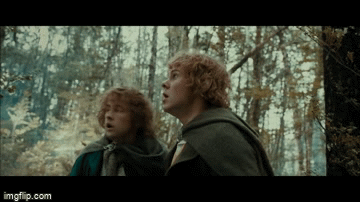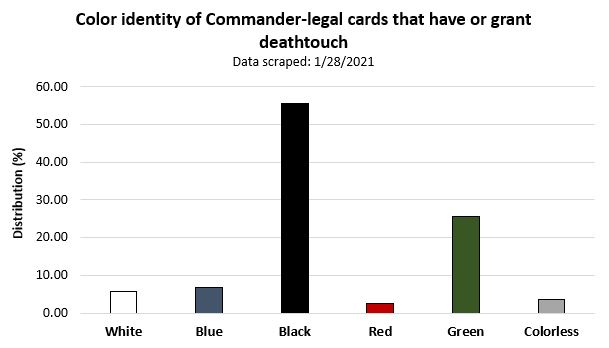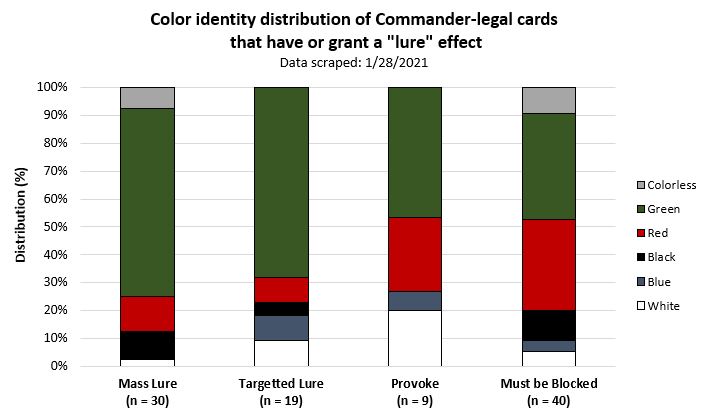(Gift of the DeityGift of the Deity | Art by Steve Prescott)
Just a Touch Of...
Greetings sleuths, saboteurs, and skulkers! Welcome to another installment of Evasive Maneuvers, where we examine keywords and strategies that help get our creatures through during combat.
This week it's double trouble: we'll be lumping together LureLure-effects with deathtouch. While each have enough support to warrant their own discussions, deathtouch and LureLure are a match made in heaven, and I'd be remiss to try and squeeze an article out of one without mentioning the other.
The concept behind deathtouch was originally introduced in Alpha with none other than Thicket BasiliskThicket Basilisk, where it was originally a triggered ability. In Future Sight and leading into Lorwyn, deathtouch gained keyword status, and it was eventually transitioned to a static ability rather than a triggered one. As of now, the rulings for it can be found under 702.2c:
"Any nonzero amount of combat damage assigned to a creature by a source with deathtouch is considered to be lethal damage for the purposes of determining if a proposed combat damage assignment is valid, regardless of that creature’s toughness."
Deathtouch is one of those tricky keywords that skirts the line with evasion by acting as a deterrent for blockers rather than straight up "I'm getting through and there's nothing you can do about this." As a result, despite it not being as effective as other forms of evasion, it does create more decision-making and agency in-game, which I think is a good thing. For all its evasive faults, deathtouch is unquestionably a highly interactive mechanic.
Lure mechanics, on the other hand, come from the namesake, LureLure, in Alpha, which compels all creatures that the defending opponent controls to block, if able. What deathtouch gives, in terms of agency, LureLure takes away. A true dream team!
Can't (Death)Touch This
As is tradition, let's start with the breakdown of cards that have or grant deathtouch (n = 244), followed by what cards exist that inhibit deathtouch's potential.
It's no surprise that deathtouch is predominately found in Golgari: between your Deathgaze CockatriceDeathgaze Cockatrice and assorted Daggerback BasiliskDaggerback Basilisks, there's a menagerie of venomous villains at your disposal.
Unlike flying or Horsemanship, which have specific blocking requirements, any creature can block a creature with deathtouch. The question is: will they?
Archetype of Finality
Let's look at the cards that outright negate deathtouch's potential, starting with Archetype of FinalityArchetype of Finality. Like its star-studded color-cycled brethren (e.g., Archetype of AggressionArchetype of Aggression), facing against an Archetype of FinalityArchetype of Finality can pose a serious impediment for your own deathtouchers, as they suddenly just lost their necrotic nudge potential. How much play does it see?
| Name | Keyword | N Commander-legal creatures printed | N inclusions (%) |
| Archetype of AggressionArchetype of Aggression | Trample | ~660 | 4,894 (2.1%) |
| Archetype of CourageArchetype of Courage | First Strike | ~390 | 3,687 (1.7%) |
| Archetype of EnduranceArchetype of Endurance | Hexproof | ~100 | 7,834 (3.4%) |
| Archetype of FinalityArchetype of Finality | Deathtouch | ~190 | 3,007 (1.2%) |
| Archetype of ImaginationArchetype of Imagination | Flying | >2,000 | 8,048 (3.2%) |
It makes a great deal of sense why Archetype of FinalityArchetype of Finality sees comparatively little play against its starry keyword counterparts. Other than being a six-mana creature that can also die to a Reclamation SageReclamation Sage, there just aren't a lot of creatures printed with deathtouch, so its potential to strip away deathtouch is fairly corner-case outside of going against your Yarok, the DesecratedYarok, the Desecrated or Queen MarchesaQueen Marchesa lists.
People run Archetype of FinalityArchetype of Finality 'cause they really want to give their other creatures deathtouch, plain and simple. When we look at its page, we see it's typically run in decks that have commanders that innately synergize with deathtouch, whether it's the proactive strategies, like Kelsien the PlagueKelsien the Plague (306 decks, 46.9% of lists), to control the board and keep it clear of creatures, or the more reactive strategies, like Ishkanah, GrafwidowIshkanah, Grafwidow (161 decks, 36.8% of lists), who want to deter attackers from looking their way.
Mirror Shield
Mirror ShieldMirror Shield is another card that can inhibits deathtouch's potential by outright inverting the combat step and killing the deathtoucher instead. As of writing (1/28/2021), it sees play in 2,294 (1% of possible) lists and for good reason: it's a budget-friendly Equipment that provides a toughness boost and hexproof, with a small corner-case of circumventing deathtouchers. As stated above, running Archetype of FinalityArchetype of Finality just to meta-game against deathtouchers likely isn't going to do you much good, but the Mirror ShieldMirror Shield provides so much additional upside, its Gorgon-gutting potential is just gravy.
With only two cards that can metagame deathtouch, it's a solid form of evasion, right?
Not quite. Deathtouch's biggest downside isn't a series of cards or a card that sees too much (or too little) play; it's your opponents' willingness to sacrifice blockers, plain and simple. If you're desperate to get in with your Isareth, the AwakenerIsareth, the Awakener, Varragoth, Bloodsky SireVarragoth, Bloodsky Sire, or Oakhame AdversaryOakhame Adversary for various effects, your deathtouch may deter the occasional blocker, but your opponent may also throw even their commander in harm's way if it means stopping your plan, let alone a chump blocker like a token or Reassembling SkeletonReassembling Skeleton that they can get back.
"Hey, You! Over Here!"

While deathtouch has some 230+ cards to its name, mass LureLure effects have roughly 30. There's an additional suite of effects that are targeted (e.g. Culling MarkCulling Mark), and nine cards that have Provoke, which target a defending player's creature during the declare attackers step, and can untap the creature to force it to block. Provoke was notably replaced by the fight mechanic after Legions. RIP Goblin GrapplerGoblin Grappler — you were too young.
The color breakdown for these various LureLure effects is as follows:
Predominately found in green followed by red, it makes sense why the colors of "Smash!" are associated with diversionary tactics and forced combat.
We see LureLure effects crop up with fun mechanics like Rampage (e.g. Gabriel AngelfireGabriel Angelfire, 29 decks, 90.6%) so that each successive blocker results in larger power boosts; indestructible commanders, like Rhonas the IndomitableRhonas the Indomitable (who also has deathtouch! 87 decks, 43.7%); or other commanders that benefit from brawling (e.g. Neyith of the Dire HuntNeyith of the Dire Hunt). We also see it paired with other high-synergy creatures, like Brash TaunterBrash Taunter, or cards like Infiltration LensInfiltration Lens to draw twice as many cards as there are opponents' creatures.
A Deadly Duo
LureLure effects can obviously be used for great evasive potential, by diverting the defending player's blocking decisions onto one creature, while the rest of your team gets through. Deathtouch can be a semi-effective form of evasion, so long as you (as the attacking player with deathtouchers) think your opponent won't want to block. Its effectiveness lies in creating uncomfortable decisions for the defending player, but as soon as they have expendable creatures or just really don't want to get hit by your Virtus, the VeiledVirtus, the Veiled, they likely can and will block.
Which is why the two were made for each other! LureLure can be slapped on a deathtouch creature and not only divert blockers for your others to get in, but suddenly put you (the attacking player) in control to destroy as many creatures as you have points of power since only 1 point of power is needed to be considered lethal.
A tag-team of mechanics go hand-in-hand with the dynamic duo of none other than Virtus, the VeiledVirtus, the Veiled and Gorm, the GreatGorm, the Great.
Just like how LureLure and deathtouch are partners, so are Gorm and Virtus, each embodying one of the respective mechanics. From a flavor perspective they are fantastically designed, with Virtus, the VeiledVirtus, the Veiled as the agile, small, black-aligned (remember our color stats above!) deathtoucher, and Gorm the GreatGorm the Great as a lumbering, defensive diversion tactic in green.
The influx of support cards for deathtouch has been a godsend for Dana Roach and other deathtouch aficionados. Deathtouch tribal decks have long been able to create effective 'pillow forts' (more like barbed-wire fort?) to encourage opponents to look elsewhere with their attacks, but typically have struggled in closing out games, outside of combos or big spells (e.g. ExsanguinateExsanguinate). Cards like Ohran FrostfangOhran Frostfang, Hooded BlightfangHooded Blightfang, Vraska, Swarm's EminenceVraska, Swarm's Eminence, and Fynn, the FangbearerFynn, the Fangbearer have been instrumental in beefing up deathtouch to be more aggressive than just defensive.
We pair some of these deathtouchers with a heavy amount of LureLure effects, just in case Gorm the GreatGorm the Great isn't available to us, or we want to slap a LureLure effect on a deathtoucher to start clearing some pesky creatures.
Lure effects
View on ArchidektCreatures (8)
- 1 Gorm the GreatGorm the Great
- 1 Golgari DecoyGolgari Decoy
- 1 Noble QuarryNoble Quarry
- 1 Ochran AssassinOchran Assassin
- 1 Prized UnicornPrized Unicorn
- 1 Taunting ElfTaunting Elf
- 1 Tempting LicidTempting Licid
- 1 Turntimber BasiliskTurntimber Basilisk
Instants and Sorceries (3)
- 1 BloodscentBloodscent
- 1 Destined // LeadDestined // Lead
- 1 Roar of ChallengeRoar of Challenge
Enchantment (3)
- 1 Gift of the DeityGift of the Deity
- 1 LureLure
- 1 Tempting LicidTempting Licid
Artifact (1)
- 1 Nemesis MaskNemesis Mask
Slapping a LureLure on Toski, Bearer of SecretsToski, Bearer of Secrets lets our team get through for damage and card draw, and Toski remains unscathed. Anara, Wolvid FamiliarAnara, Wolvid Familiar (as well as Dolmen GateDolmen Gate) keeps Gorm, the GreatGorm, the Great safe to continue being the big distraction that he is, and they allow Virtus, the VeiledVirtus, the Veiled to swing with reckless abandon. Falthis, Shadowcat FamiliarFalthis, Shadowcat Familiar may be redundant with Virtus's deathtouch, but giving Gorm the GreatGorm the Great deathtouch gets real nasty, and the menace for Virtus is over the top.
Putting it all together, we have a combination of mechanics and commanders so closely bonded that they could likely pull Gold at the next winter Olympics pairs skating:
The Bad Touch
View on ArchidektCommander (2)
- 1 Gorm the GreatGorm the Great
- 1 Virtus the VeiledVirtus the Veiled
Creatures (30)
- 1 Acidic SlimeAcidic Slime
- 1 Ambush ViperAmbush Viper
- 1 Anara, Wolvid FamiliarAnara, Wolvid Familiar
- 1 Archfiend of DespairArchfiend of Despair
- 1 Dire Fleet RavagerDire Fleet Ravager
- 1 Falthis, Shadowcat FamiliarFalthis, Shadowcat Familiar
- 1 Foulmire KnightFoulmire Knight
- 1 Fynn, the FangbearerFynn, the Fangbearer
- 1 Glissa, the TraitorGlissa, the Traitor
- 1 Golgari DecoyGolgari Decoy
- 1 Gonti, Lord of LuxuryGonti, Lord of Luxury
- 1 Harvester of SoulsHarvester of Souls
- 1 Hooded BlightfangHooded Blightfang
- 1 Isareth the AwakenerIsareth the Awakener
- 1 Leyline ProwlerLeyline Prowler
- 1 Nighthawk ScavengerNighthawk Scavenger
- 1 Noble QuarryNoble Quarry
- 1 Oakhame AdversaryOakhame Adversary
- 1 Ochran AssassinOchran Assassin
- 1 Ohran FrostfangOhran Frostfang
- 1 Poison-Tip ArcherPoison-Tip Archer
- 1 Prized UnicornPrized Unicorn
- 1 Raving DeadRaving Dead
- 1 Taunting ElfTaunting Elf
- 1 Tempting LicidTempting Licid
- 1 Thorn of the Black RoseThorn of the Black Rose
- 1 Toski, Bearer of SecretsToski, Bearer of Secrets
- 1 Turntimber BasiliskTurntimber Basilisk
- 1 Vampire NighthawkVampire Nighthawk
- 1 Varragoth, Bloodsky SireVarragoth, Bloodsky Sire
Instants (5)
- 1 BloodscentBloodscent
- 1 Destined // LeadDestined // Lead
- 1 Gaze of the GorgonGaze of the Gorgon
- 1 Khalni AmbushKhalni Ambush
- 1 Malakir RebirthMalakir Rebirth
Sorceries (13)
- 1 Ambition's CostAmbition's Cost
- 1 Ancient CravingAncient Craving
- 1 Bala Ged RecoveryBala Ged Recovery
- 1 CultivateCultivate
- 1 Fraying OmnipotenceFraying Omnipotence
- 1 HarmonizeHarmonize
- 1 Kodama's ReachKodama's Reach
- 1 Night's WhisperNight's Whisper
- 1 Rampant GrowthRampant Growth
- 1 Roar of ChallengeRoar of Challenge
- 1 Sign in BloodSign in Blood
- 1 Skull StormSkull Storm
- 1 Three VisitsThree Visits
Artifacts (9)
- 1 Arcane SignetArcane Signet
- 1 Bow of NyleaBow of Nylea
- 1 Dolmen GateDolmen Gate
- 1 Infiltration LensInfiltration Lens
- 1 Lightning GreavesLightning Greaves
- 1 Nemesis MaskNemesis Mask
- 1 Sol RingSol Ring
- 1 Swiftfoot BootsSwiftfoot Boots
- 1 Tome of LegendsTome of Legends
Enchantments (4)
- 1 Deathreap RitualDeathreap Ritual
- 1 Gift of the DeityGift of the Deity
- 1 LureLure
- 1 Wound ReflectionWound Reflection
Planeswalkers (1)
- 1 Vraska, Swarm's EminenceVraska, Swarm's Eminence
Lands (36)
- 1 Bojuka BogBojuka Bog
- 1 Command TowerCommand Tower
- 14 ForestForest
- 1 Hissing QuagmireHissing Quagmire
- 1 Llanowar WastesLlanowar Wastes
- 1 Overgrown TombOvergrown Tomb
- 1 Rogue's PassageRogue's Passage
- 1 Scavenger GroundsScavenger Grounds
- 12 SwampSwamp
- 1 Undergrowth StadiumUndergrowth Stadium
- 1 War RoomWar Room
- 1 Woodland CemeteryWoodland Cemetery
Conclusion
That concludes our deathly duo!
But what do you think? Do you use deathtouch, and if so, for a more offensive or defensive strategy? Do you enjoy the support we've gotten for making deathtouch more aggressive? Do you prefer evasion that promotes decision making in combat, or just plain circumvents it? Sound off in the comments below!
Trent Trombley
Trent has been playing Magic since the early 2000s, when instead of exercising in a summer sports camp, he was trying to resolve a Krosan Skyscraper on the sidewalk (it always ate a removal). He saved up his allowance to buy an Akroma Angel of Wrath on eBay, only to find out it was a fraudulent post, forever dashing his hopes of ever getting a big creature to stick. He’s since “grown up” and, when he’s not working on his dissertation in Archaeology, spends too much time thinking how to put Cipher in every one of his decks and digging for obscure cards (see photo).
Your opinions are welcome. We love hearing what you think about Magic! We ask that you are always respectful when commenting. Please keep in mind how your comments could be interpreted by others. Personal attacks on our writers or other commenters will not be tolerated. Your comments may be removed if your language could be interpreted as aggressive or disrespectful. You may also be banned from writing further comments.


